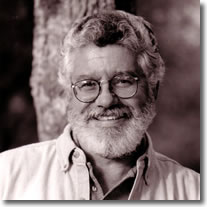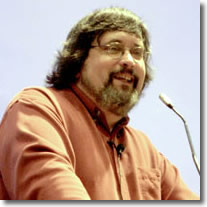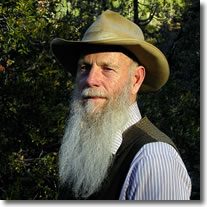Contributors to This Issue
Dan DeFoe
 Daniel DeFoe is Professor of History and Communication Studies at Sierra College. A graduate of Fresno State, Dan has advanced degrees and training from CSU Sacramento (M.A. History) and U.C. Davis (Ph.D. program). He has been at the Rocklin campus since 1990. DeFoe has been named Sierra College “Teacher of the Year” on nine occasions.
Daniel DeFoe is Professor of History and Communication Studies at Sierra College. A graduate of Fresno State, Dan has advanced degrees and training from CSU Sacramento (M.A. History) and U.C. Davis (Ph.D. program). He has been at the Rocklin campus since 1990. DeFoe has been named Sierra College “Teacher of the Year” on nine occasions.
Prior to joining the faculty, Dan was employed for many years in the television and advertising industries and earned multiple awards for his work.
Joe Medeiros
 Joe Medeiros has hiked and studied in the Sierra for more than 35 years, lead countless trips of students and mountain enthusiasts, served as a National Park Ranger at Devils Postpile National Monument in the southern Sierra Nevada, and loves to share photographs and stories about his favorite place in the world. Medeiros recently retired from teaching biology at Sierra College, and was coordinator of the college’s Interdisciplinary Program and many campus events, such as Earth Day. Joe has been honored as Sierra College Teacher of the Year in 1999, 2003, 2005 and 2008. He also taught for many years at Modesto Community College and was Director of the college’s outstanding Great Valley Museum.
Joe Medeiros has hiked and studied in the Sierra for more than 35 years, lead countless trips of students and mountain enthusiasts, served as a National Park Ranger at Devils Postpile National Monument in the southern Sierra Nevada, and loves to share photographs and stories about his favorite place in the world. Medeiros recently retired from teaching biology at Sierra College, and was coordinator of the college’s Interdisciplinary Program and many campus events, such as Earth Day. Joe has been honored as Sierra College Teacher of the Year in 1999, 2003, 2005 and 2008. He also taught for many years at Modesto Community College and was Director of the college’s outstanding Great Valley Museum.
John Muir
 Muir died of pneumonia in a Los Angeles hospital in January, 1914. It was a unexpectedly prosaic end for a man who had repeatedly faced death on rocky crags and icy glaciers, who braved Alaskan storms with a crust of bread in his pocket. In the years since, his legend has grown. In 1976, the Calfiornia Historical Society voted him "The Greatest Californian." The U.S. Geological Survey has suggested an even greater mark of his fame. In their guidelines on naming mountains and lakes after individuals, it gives Muir as the example of someone who has had so many things named for him already that they would not be likely to approve any further such commemorations.
Muir died of pneumonia in a Los Angeles hospital in January, 1914. It was a unexpectedly prosaic end for a man who had repeatedly faced death on rocky crags and icy glaciers, who braved Alaskan storms with a crust of bread in his pocket. In the years since, his legend has grown. In 1976, the Calfiornia Historical Society voted him "The Greatest Californian." The U.S. Geological Survey has suggested an even greater mark of his fame. In their guidelines on naming mountains and lakes after individuals, it gives Muir as the example of someone who has had so many things named for him already that they would not be likely to approve any further such commemorations.
Gaylord Nelson
 In 1969, as a U.S. Senator from Wisconsin, Gaylord Nelson came up with one of the most powerful ideas of his time: Earth Day. Inspired by the teach-ins dealing with the Vietnam War, Earth Day was an instant success, drawing 20 million participants the first year (1970). American Heritage Magazine called the first Earth Day "one of the most remarkable happenings in the history of democracy." Earth Day began in 1970
In 1969, as a U.S. Senator from Wisconsin, Gaylord Nelson came up with one of the most powerful ideas of his time: Earth Day. Inspired by the teach-ins dealing with the Vietnam War, Earth Day was an instant success, drawing 20 million participants the first year (1970). American Heritage Magazine called the first Earth Day "one of the most remarkable happenings in the history of democracy." Earth Day began in 1970
Founded by Senator Gaylord Nelson, Earth Day is an annual event which was first celebrated on April 22 1970 by 20 million people from across the country. It’s been hailed as one of the most remarkable happenings in the history of democracy.
Dr. Jeff Price
 Dr. Jeff Price is a biologist and Professor of Geological and Environmental Sciences at CSU Chico. Along with co-authoring the IPCC Fourth Assessment Report (ecosystems), the IPCC Third Assessment Report (ecosystems), and the IPCC Technical Paper on Climate Change and Biodiversity, he also contributed text to the U.K. Government's Stern Review of the Economic Impacts of Climate Change and U.S. National Assessment on Climate Change Impacts on the United States. He was co-author of the Nature article "Fingerprints of global warming on wild animals and plants", of the publication The Birdwatcher's Guide to Global Warming as well as a number of scientific papers on the potential impacts of global warming on birds.
Dr. Jeff Price is a biologist and Professor of Geological and Environmental Sciences at CSU Chico. Along with co-authoring the IPCC Fourth Assessment Report (ecosystems), the IPCC Third Assessment Report (ecosystems), and the IPCC Technical Paper on Climate Change and Biodiversity, he also contributed text to the U.K. Government's Stern Review of the Economic Impacts of Climate Change and U.S. National Assessment on Climate Change Impacts on the United States. He was co-author of the Nature article "Fingerprints of global warming on wild animals and plants", of the publication The Birdwatcher's Guide to Global Warming as well as a number of scientific papers on the potential impacts of global warming on birds.
Lee Stetson
 Lee Stetson's plays include three one-person shows based on the life of the naturalist John Muir, and a fourth based on both Muir and President Theodore Roosevelt. These productions, with Mr. Stetson in the title role, have been presented in Yosemite National Park since 1983 to more than a quarter of a million visitors. Additionally, the Muir shows have toured throughout the country to universities, parks, museums, wilderness and environmental organizations from Washington D.C. to Hawaii. Stetson lectures frequently on the arts and the environment, and spends a considerable portion of his time promoting the performing arts in the national parks. Lee's career has included founding and managing the Hawaii Performing Arts Company, being the Artistic Manager of both the Hawaii Theatre Festival and the Antique Theatre Festival of Idaho, and freelance directing throughout the Northwest and in Los Angeles. As an actor he has performed more than fifty major roles from Shakespeare to Simon, and his television credits include a dozen episodes of Hawaii 5-0 and appearances on two PBS documentaries about Muir. Lee has performed annually at the Sierra College Earth Day celebrations for many years and was elected as a Mariposa County Supervisor in 2004.
Lee Stetson's plays include three one-person shows based on the life of the naturalist John Muir, and a fourth based on both Muir and President Theodore Roosevelt. These productions, with Mr. Stetson in the title role, have been presented in Yosemite National Park since 1983 to more than a quarter of a million visitors. Additionally, the Muir shows have toured throughout the country to universities, parks, museums, wilderness and environmental organizations from Washington D.C. to Hawaii. Stetson lectures frequently on the arts and the environment, and spends a considerable portion of his time promoting the performing arts in the national parks. Lee's career has included founding and managing the Hawaii Performing Arts Company, being the Artistic Manager of both the Hawaii Theatre Festival and the Antique Theatre Festival of Idaho, and freelance directing throughout the Northwest and in Los Angeles. As an actor he has performed more than fifty major roles from Shakespeare to Simon, and his television credits include a dozen episodes of Hawaii 5-0 and appearances on two PBS documentaries about Muir. Lee has performed annually at the Sierra College Earth Day celebrations for many years and was elected as a Mariposa County Supervisor in 2004.
Carl Zichella
 Carl Zichella is the Sierra Club’s Regional Staff Director for California, Nevada and Hawaii. His region includes more than 210,000 Sierra Club members. Nationwide, the Sierra Club has more than a million members.
Carl Zichella is the Sierra Club’s Regional Staff Director for California, Nevada and Hawaii. His region includes more than 210,000 Sierra Club members. Nationwide, the Sierra Club has more than a million members.
The Sierra Club was founded in 1892 by a group of concerned California residents led by the famous author and preservationist John Muir. The club is a national organization with a worldwide perspective. It is dedicated to the preservation and expansion of the world's parks, wildlife, and wilderness areas. The organization was instrumental in creating the United States National Park Service. Through a program of litigation and congressional action, the Sierra Club has opposed efforts that despoil the environment, such as strip mining, the use of harmful pesticides, offshore oil drilling, and hazardous wastes. The Sierra Club also investigates the urban environment, protection of tropical forests, and overpopulation.
